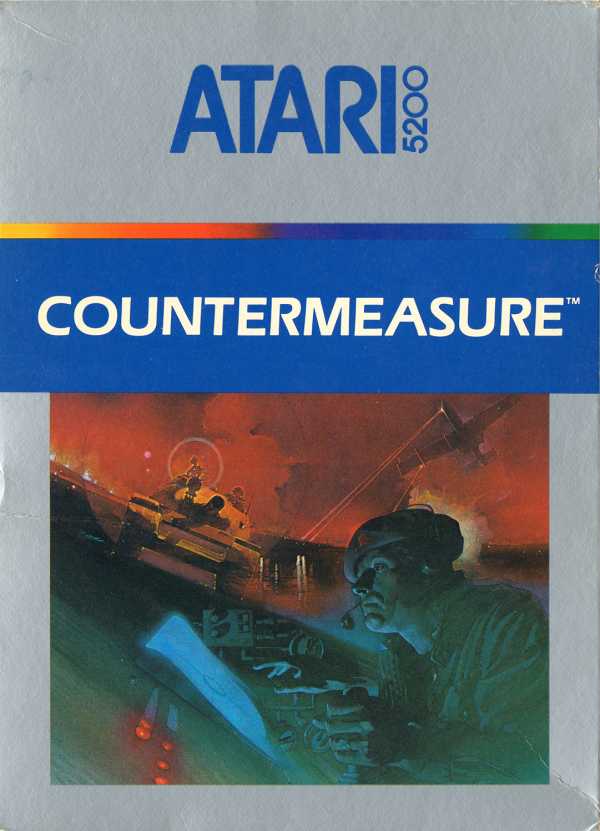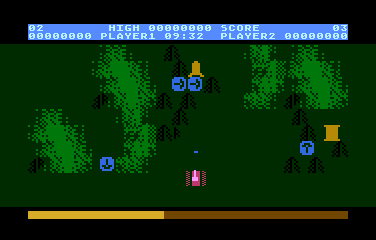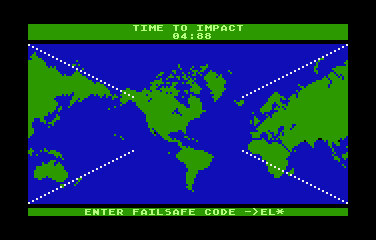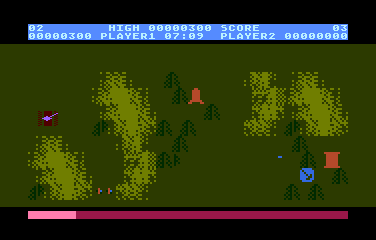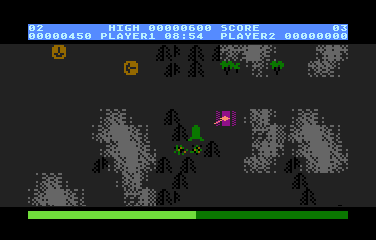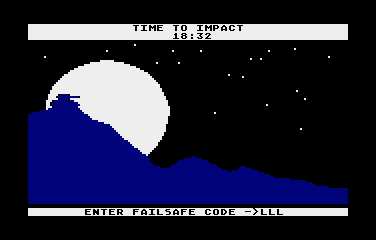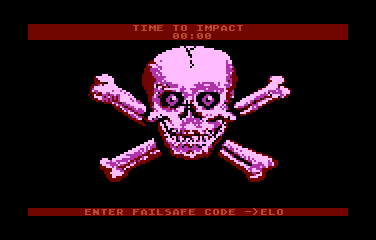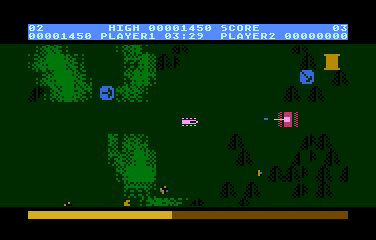Games That You Should Try Again
COUNTERMEASURE
The Atari 5200 SuperSystem appeared in late 1982, at which time the company started selling the earlier Video Computer System under its own model number, 2600. It's actually part number CX2600, but the greater length presumably didn't appeal to the marketers, who surely knew that any battle to boast the Most Needlessly Overloaded and Baffling System Name had been indisputably won by Texas Instruments with its TI-99/4A.
When Atari originally hinted at its new console in magazines, it was referred to as System X. I later came to call it System Why? in an attempt to be clever (and yes, others have ripped that off, but it's cool), as this allegedly new, "super" contrivance was an Atari eight-bit computer without the keyboard and a few other computery functions.
In fact, Adam has explained to me that its microchip set would technically make it an Atari 600. Some of the chips' addresses had been changed, necessitating alterations to a given piece of software's machine-language code -- and the POKEY chip and controller ports were modified to handle analogue input, rather than the standard digital -- but most of the cartridges otherwise harbored games that were already available for Atari's 400 and 800. Some had to be resized for less memory, but they played and looked the same.
A handful was specifically created for the 5200, however, and these games were never (officially) converted for other platforms. Readers of the Classic-Gaming Bookcast know that I like to feature "this system only" games, as so many great ones have been elsewhere dismissed or overlooked. As far as I'm concerned, the best exclusive for this console was called -- and still is, for that matter -- Countermeasure. It combines the joy of learning new math skills with music-notation lessons.
Not at all, of course. This is a scrolling shoot-'em-up with some elements taken from 1981's Strategy X coin-op by Konami (released by Stern here in North America). But you know how I am about originality, and this '82 jewel bears facets that, when combined, make it distinctive indeed and highly enjoyable -- as long as one takes the time to really get into it and learn the nuances.
You're in a tank, and there are things you have to find (attracting the Adventure lover in me from the get-go). Hostile installations stand scattered and ready to blast you from uncommonly long distances -- those are some seriously resilient shells -- but they can be outfoxed and neatly wiped from the face of the patchwork terrain if they're approached with care. The slow and watchful strategizing that best serves the player isn't tedious, as it could have been in the hands of programmers other than Leo Salinas and John Seghers, but refreshing, as it keeps this from being an orthodox shooting game with player-memorized enemy successions and that kind of tired thing.
Depending on which way your tank rolls, the playfield scrolls to the north or south, and exhibits an unpredictability that represents one of the reasons I dig this game so much: Graphics man Alan Murphy's minor chunks of landscape that make up the whole are individually pre-arranged, but nonetheless laid out randomly as they come into view from the north (at your whim, as the scroll isn't mechanized). Even more impressively from a programming standpoint, if you backtrack to the south, they remain consistent with what you've seen.
What you're looking for is a three-letter code that will disarm the enemy's own SuperSystem, a nuclear missile-launching computer that will annihilate whatever country you happen to live in! Oh, no! You'll want to enter the letters in time to forego that mushroom-clouded death of millions (how '80s, huh?). The letters from which the game randomly chooses, so to speak, are E, L and O. If you keep your cool and don't turn to stone -- and play a few times for practice -- you'll prevail. Charging forward and doggedly trying to "shoot them before they shoot you" is going to reward you with a big pile of scrumptious, oven-roasted tank parts.
Deep in the Hundred-Acre Wood, your rivals, the Evil Woodsmen of the Perpetually Dark Planet Whose Continents Are Shaped Exactly Like Earth's, have left paper fragments of their disarming code just lying around, invariably near the bases of the Roman columns they've collected and converted into giant fuel tanks. So there's something in your favor: They're not very bright rivals. And level after level, they never learn. "Maybe we oughta keep this code locked in a desk drawer or something. What? We don't have any desks? Damn, we're evil! Good for us! Well, we should hide it somewhere. Does anyone around here sleep on a mattress, at least?"
You'll find none of that in the manual, though. You've been lucky enough to stumble upon another OC&GS exclusive! Returning to the technical details, whenever you stop to gas-up your tank at one of the columns (that's your gauge at the bottom), you're shown a letter, along with its position in the warhead-deactivating Fail-Safe Code. Bear in mind that it might be repeated, even twice.
If you draw very near to one of the silos, initiating the map-and-menacingly-moving-missiles screen, and type the letters in the correct order, the rockets fall harmlessly into the seas, prompting your expedition into differently colored forests and towns. Those Evil Woodsmen rebuild pretty quickly.
As the levels proceed, everything (including, happily, your tank) accelerates, and all shots' uniform maximum distance increases, so you'll want to address the automated but perilous pillboxes from progressively farther away. Every shell travels longer diagonally than cardinally.
If you decide to enter a silo before locating the entire code, intending to risk a partial or total guess via various combinations, it's best to wait until you've found at least one letter, as you'll now have fifteen seconds before impact, rather than whatever remains of the preliminary ten minutes -- game minutes, that is, as the timer counts down faster on higher levels.
While beating a level is a satisfying accomplishment, the real fun lies in playing peek-a-boo with the gun emplacements -- and, sensibly enough, wiping them out. These immobile, persistently pivoting toilet plungers are initially the only defenses deployed by the Evil Woodsmen. Like your tank, they can shoot to any of eight headings. Take into account that during each of its clockwise rotations (apart from the peaceful first two as the game begins), every plunger in view will fire at you as accurately as possible, but only once.
The range of your projectiles and the plungers' is the same, so the tactic for taking one out while avoiding tank loss -- which can easily be caused by a concurrent exchange of firepower, even when you've hit your mark -- is to note the precise angle of the enemy shot by minutely rolling ahead as bait and then backward to safety. Once you've keenly pinpointed the deadly firing line, and the plunger has just begun to rotate away from you, hasten forward, shoot along the same trajectory (in the opposite direction, naturally) and promptly reverse, thus dodging the return fire in the event that your opponent has had time to swivel all the way around again. When there's more than one gun on screen, their revolutions are seldom synchronized, so it's wise to mind crossfire.
There's a lot about this game that makes it feel good to play. Your freedom to develop your own playing style and advance through the environs exactly as you please, instead of being confined to a particular speed and maze-like route, is certainly a factor. Granted, your tank rolls much more slowly over trees and buildings (as you might imagine), as well as burning debris you've created. But it's so much fun to sneak up on a pillbox -- or two, as they're occasionally paired -- optically trace the most threatening firing angle, thoughtfully return the shot, and abruptly back out of harm's way. "Oooooops! Missed me!"
Well, as much as one can sneak up in a tank, anyway. You're driving a special collector's model, as it doubles as a riding lawnmower, judging by all the noise. There's something of a safe spot between angles of enemy shelling, as the diagonals are horizontally narrow. Once you're at home with the game's mechanics, you'll recognize how to aptly approach the pillboxes without imperiling your mower.
You can all fire through trees and over buildings and rubble, but take care, as your shots will obliterate the fuel depots and missile silos. Why there aren't colossal detonations when this happens, only the Woodsmen know.
About five minutes in, a new challenger emerges from the side: a car full of nerds who throw eggs at you. They've somehow managed to pack them with explosives, so turn and teach them a valuable (albeit brief) lesson the instant you notice a rolling patch of blue or pink among the brush. Your shells always fly farther than their eggs. That should go without saying, but one of the awesome things about video games is that anything is possible.
Later still, an intermittent cruise missile joins the proceedings and homes in on your tank, but unless you've rendered it indestructible by selecting or reaching Level 9, this attempt is usually fleeting, as a mere brush with tree leaves blows it up. As I've mentioned, your adversaries aren't the brainiest in Game Land.
An alternative level-beating method is to destroy all seven silos that you'll eventually encounter as you travel northward. I always go with the code, so I don't have to concern myself with the ten-minute deadline or my diminishing fuel. There's a lot of ground if you're hoping to cover all of it, and if you run out of petrol, your tank does something perfectly logical: It bursts into flame.
In return for saving all of the non-evil people on the planet, you'll receive 10,000 points and the resultant extra tank, and you'll get to...park on a mountain! You can't get out, of course. Well, at least there's plenty of light for reading.
Here's what happens when time runs out before you enter the right sequence. The bad guys' unique type of radiation apparently covers the world with a giant pirate flag. Not cool, fellas! By the way, there's an Easter egg near the upper-left bone tip: Alan Murphy's initials.
What's odd is that the game's not over at this point. You just lose a tank and move on to the next level. Well, it's not as if you have a home to return to now, so you may as well stick around. The good guys certainly won't let you camp on their mountain anymore.
Those who dropped big money for new SuperSystems were undoubtedly thrilled to discover that their massive new machines had come with rare features: Super Extra Bonus Deluxe Joysticks that were analogue, non-auto-centering, fragile and nearly impossible to use with games that required unusual, finicky moves, such as turning at right angles.
More accurate and durable sticks were eventually sold by other firms, but the console's own company discontinued it in mid-1984, so there ultimately wasn't much third-party involvement, game-wise or otherwise. In fact, it wasn't released outside of North America, so there was never, for instance, a SuPALSystem.
At least each controller contains two action buttons and a number keypad that can hold overlays, not to mention a pause button. Countermeasure is one of the 5200's very few games that put all of these to use. The ability to halt the action is obviously useful in any case, but the two buttons respectively fire and, while depressed, allow for rotating your turret without turning your tank. The keypad is for entering the Fail-Safe Code, of course, as well as selecting the firing method (i.e. whether or not your tank keeps rolling while its turret is moving), player amount (of two, who take turns) and starting difficulty level (of ten).
When the console was current and a bit thereafter, a kind and philanthropic hacker who called himself Glenn the 5200 Man, and whose real name is Glenn Botts, adapted this game and others to load from disks and run on Atari computers, also amending the code to handle digital controls and a solitary fire button. I can hence play by way of Altirra, the Atari 400/800/etc. emulator, using my beloved CX40 joystick with a Stelladaptor. Tapping the single button fires, whereas holding it down enables gun pivoting. It doesn't take long to get used to. This isn't how I first played the game, however.
Speaking of things given to me by Adam, such as that adapter for my PC, the 5200 was one of several systems comprising his 1997 Christmas gifts to me (which included heaps of software, manuals and peripherals). He had sent off his two broken SuperSticks to be repaired, so that I could have all the original hardware, which also consisted of the console's anomalous RF switch-bound power jack and the gigantic, hard-plastic case Atari had sold separately.
Countermeasure was one of the cartridges he gave me, and it was the game I found most suited to the analogue stick. Lead programmer Leo ensured that a lot of attention was given to the controls, so he was entirely justified in using an anagram of his first name for each possible Fail-Safe Code.
He doesn't appear to have written any other games, apart from an unreleased 1983 SuperSystem game called Sport Goofy, based on the Disney character and converted for computer use in 2005 by Homesoft, a latter-day Glenn equivalent. John went on to program Gremlins, RealSports Soccer and a prototype called Xari Arena, all for the 5200, whereas Alan's graphics appeared in, most notably, 2600 Defender and Demons to Diamonds, as well as 5200 Pac-Man, Galaxian and another Glenn-adapted favorite of mine, the only contemporary home version of Taito America's twin-stick Space Dungeon from '81.
Adam recently alerted me that in 2010, Bob DeCrescenzo created an Atari 7800 sequel to Countermeasure that he called FailSafe, a name derived from one of the original's working titles. An earlier one was Tank, which induces speculation: Was the game initially meant to be an enhanced rendition of a certain Atari arcade series from the '70s, as Bob Polaro's 2600 Sprint Master would be in '88?
I haven't played FailSafe, but I've watched it. It appears to be a commendable follow-up, with additions such as temporary power-ups; more types of terrain, including bodies of water; a four-digit code (based on the hexadecimal system known well by Assembly programmers); landmines and human foes that hide behind bunkers to evade your shots. The scroll is horizontal rather than vertical, and your turret is no longer controlled separately, but the game was done extremely well, which isn't surprising, considering Bob's reputation with 7800 players.
Countermeasure is an impressive early release for a high-hopes system that ended up being a curio. If Atari had only simplified and pushed their likewise laudable eight-bit computer line instead of trying to pass off a keyboard-free edition as a cutting-edge console...but retrospection is all too easy. For example, since I keep trouncing them, I'll bet those Evil Woodsmen wish they had stuck with their original plan to open a Christmas-tree lot.
